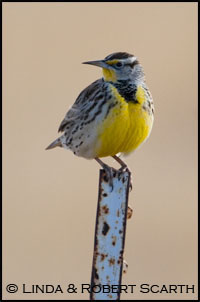introduction - galleries - technique - catalogue - notes - links - contact - blog - deep nature

Western Meadowlark
Spring moves north each year at a steady pace and with it the native and horticultural blooms in garden and woodland, the migrating birds and the reappearance of butterflies and other insects. This year spring seemed to come early and sporadically before retreating again. There has been spring rain and spring snow. Record high temperatures were set in March in many parts of the Midwest. The Virginia Bluebells that foolishly emerged and showed buds on April 1, were frost-nipped on April 6 this year. Trout Lilies did the same though they seem a bit sturdier. Our large patches of native violets are leafed out and now limp. The Golden Alexander was six inches tall by April 1. The Bloodroot popped out of the ground in the March heat wave and bloomed at about 2 ? inches high much like the tiny Snow Trilliums. The winter was mild enough that Bird?s Nest fungi were in good condition and had an insect visitor in late March this year.
Those who keep track of the seasonal cycles of plants and animals have been noting the changes as some climate patterns (including precipitation or lack thereof) move north. There are individuals and organizations that make these phenological observations. Some do so without formal programs in their own journals and websites. Groups and organizations have projects dedicated to studying change. There is a web site that keeps track of the first morels seen each year. In the southeastern states morels were found in February. By the end of March this year morels were found in southern Illinois.
It is interesting to note that their map of first dates roughly corresponds with the cold hardiness zones used by gardeners and foresters. The Arbor Day Foundation web site had two maps showing the changes in hardiness zones between 1990 and 2006. The 1990 map placed two thirds of Iowa in zone 4. The 2006 map has all of Iowa in Zone 5 with zone 6 creeping into the far southeast part. These changes in temperature patterns mean that photographers and naturalists have to start looking for subjects earlier in the year.
Birders who observe the phenology of bird arrival dates during spring migration are noting that some species are arriving one to two weeks earlier than in the past. The Breeding Bird Survey, managed by the U.S. Geological Survey and Canadian Wildlife Service, has data indicating that breeding ranges are also heading north, in addition to early spring migration. A study done at the University of Louisiana ? Lafayette documented twenty six southern species whose breeding ranges have changed significantly since the 1960s. Twenty four species moved north as much as 200 miles while two have retreated southward.
The Lakeshore Preserve at the University of Wisconsin reminds observers that not all phenological records need to be biological. They note that there is a steady downward trend in the number of days Lake Mendota is ice covered. Their web site offers suggestions for observations in each of the four seasons. The Wisconsin Phenological Society provides a phenology guide on its website. The guide defines the things we all delight in finding: first flower, first leaf, peak bloom. It also provides a species calendar of when woodland flowers might be found. The USA National Phenological Network and Nature?s Calendar organization in the United Kingdom are other good sources of information. The Hummingbird observers also keep track of migration dates.
Each spring we look forward to finding early flowers and following the progression with our cameras. It appears we will need to pay more attention to the weather than the calendar if we are to locate flowers in peak bloom, fresh butterflies and birds in breeding plumage. Though we haven?t kept formal journal phenological records, our image file dates and diary notes of sites visited remind us to get out in the field a bit earlier. We are already waiting for the first Dicksissel of the year.
© Linda & Robert Scarth, 2007.
